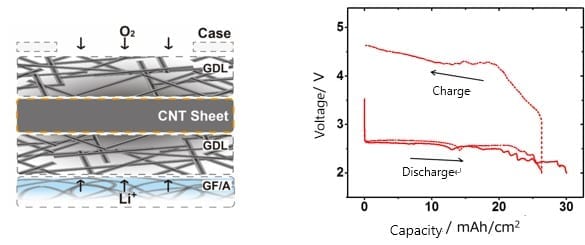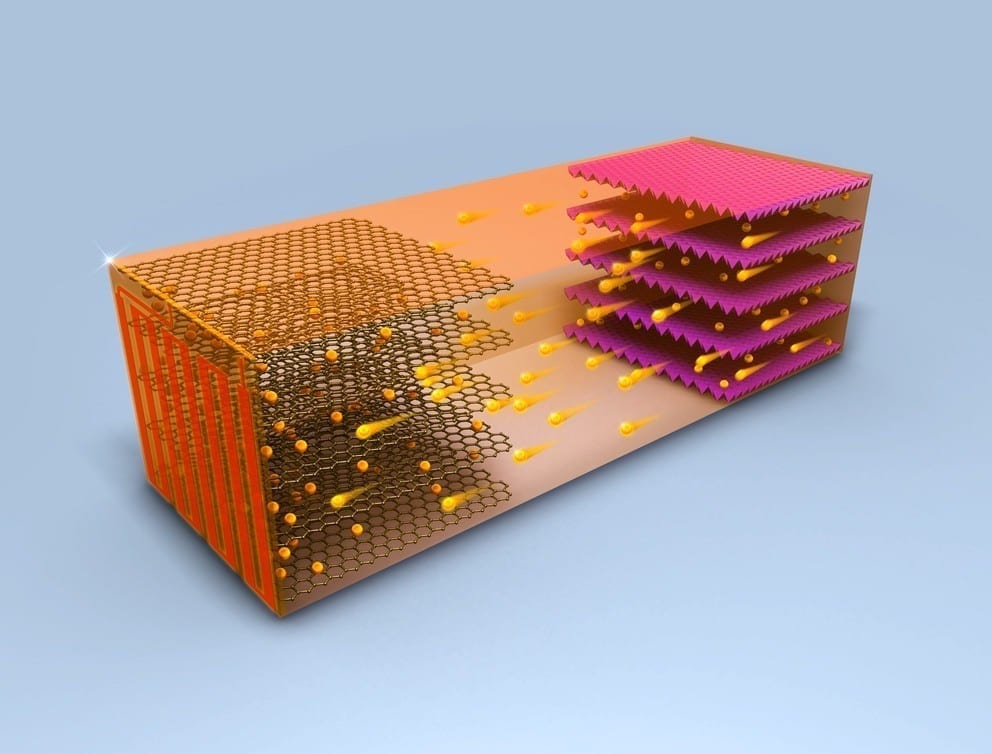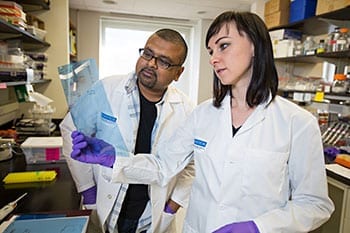
Development of Ultra-High Capacity Lithium-Air Batteries Using CNT Sheet Air Electrodes
The new battery may enable electric vehicles to drive as far as conventional vehicles.
A NIMS research team developed lithium-air batteries with very high electric storage capacity—15 times greater than the capacity of conventional lithium-ion batteries—using carbon nanotubes as an air electrode material. (“CNT Sheet Air Electrode for the Development of Ultra-High Cell Capacity in Lithium-Air Batteries”, Akihiro Nomura, Kimihiko Ito & Yoshimi Kubo, Scientific Reports 7, Article number: 45596 (2017), doi:10.1038/srep45596)
- A NIMS research team led by Yoshimi Kubo and Akihiro Nomura, team leader and researcher, respectively, Lithium Air Battery Specially Promoted Research Team, C4GR-GREEN, developed lithium-air batteries with very high electric storage capacity—15 times greater than the capacity of conventional lithium-ion batteries—using carbon nanotubes (CNT) as an air electrode material.
- Demand for rechargeable batteries is expected to increase rapidly as electric vehicle power sources and joint sources of household electricity with solar cells. The current lithium-ion batteries have advantages of being compact, producing high voltages, and having long life, but they also have an issue in that their energy densities, which represent electric storage capacities, have nearly reached a limit. Lithium-air batteries have great potential in overcoming this issue. The lithium-air battery is the “ultimate rechargeable battery” with the highest energy density in theory. The battery may have drastically large capacity and reduce production cost. However, conventional battery research usually focuses on basic studies of battery reactions using small amounts of materials, and therefore is not designed to demonstrate large battery capacities using cells of actual size and shape.
- The research team recently achieved very high electric storage capacity of 30 mAh/cm2 using realistic cell forms. This value represents about 15 times greater capacity compared to the capacity of conventional lithium-ion batteries (about 2 mAh/cm2). This achievement was made by using CNTs as an air electrode material and thereby optimizing the electrode’s microstructure. We think that the battery’s large capacity can be attributed to CNTs’ large surface area and flexible structure. It is unlikely that existing knowledge can explain the capacity increase seen in this study, and these findings may stimulate discussion over lithium-air battery reaction mechanisms.
- In light of these results, we aim to develop genuinely high-capacity lithium-air batteries at the practical level by exploring techniques to increase energy density in cell layers, called a stack, and remove impurities from the air.
Learn more: Development of Ultra-High Capacity Lithium-Air Batteries Using CNT Sheet Air Electrodes
[osd_subscribe categories=’lithium-air-batteries’ placeholder=’Email Address’ button_text=’Subscribe Now for any new posts on the topic “LITHIUM-AIR BATTERIES’]
The Latest on: Lithium-air battery
[google_news title=”” keyword=”lithium-air battery” num_posts=”10″ blurb_length=”0″ show_thumb=”left”]- Fuse Battery Announces Consolidation
Fuse Battery Metals Inc. (“the Company” or “Fuse”) (TSXV: FUSE, OTCQB: FUSEF, FRA: 43W3) announces that in order for the Company to evaluate and reorganize ...
- Scientists make breakthrough with high-power lithium-sulfur batteries: 'Our research shows a significant advancement'
A research team at the University of Adelaide in Australia may have turned a corner regarding lithium-sulfur batteries — their lab work indicates a recent breakthrough that can drastically increase ...
- Unveiling the CATL solid-state battery route
TrendForce has learned that at the CIBF2024 Advanced Battery Frontier Technology Symposium on April 28, Wu Kai, Chief Scientist of CATL, announced ...
- Wendell Special Town Meeting to decide on battery storage bylaw
Residents are being summoned to Town Hall on Wednesday to have their voices heard on a bylaw proposed to regulate battery energy storage systems.A Special Town Meeting is slated to begin at 7 p.m., ...
- Batteries News
a group of researchers has created a paper-based magnesium-air battery that can be used in GPS ... New Materials Discovered for Safe, High-Performance Solid-State Lithium-Ion Batteries Apr. 2 ...
via Google News and Bing News










